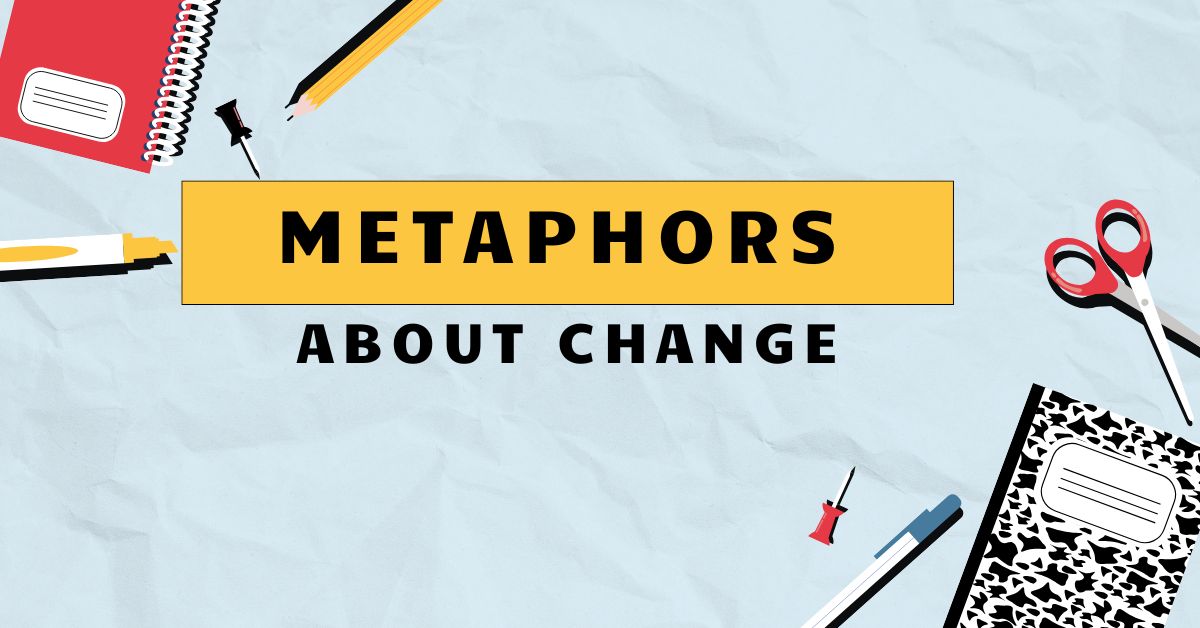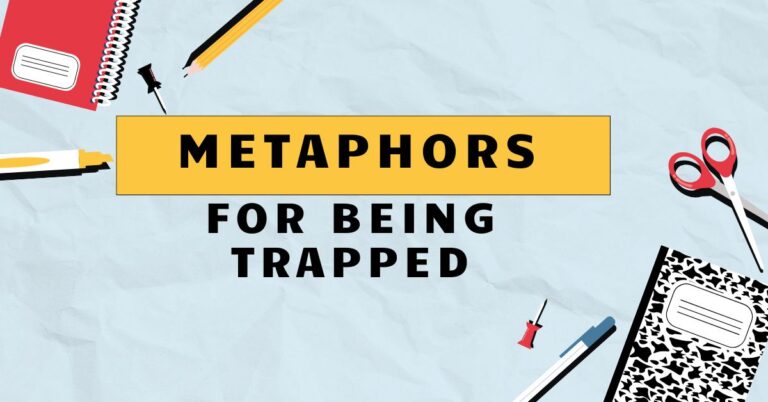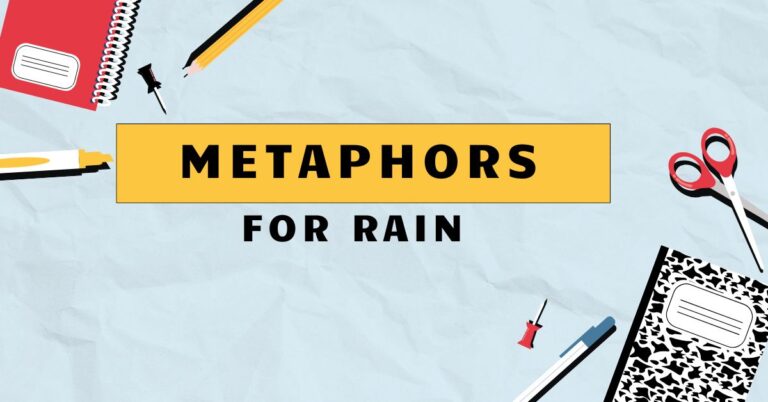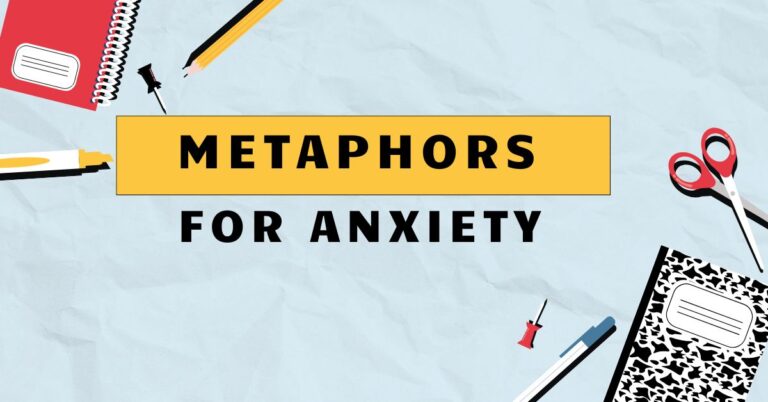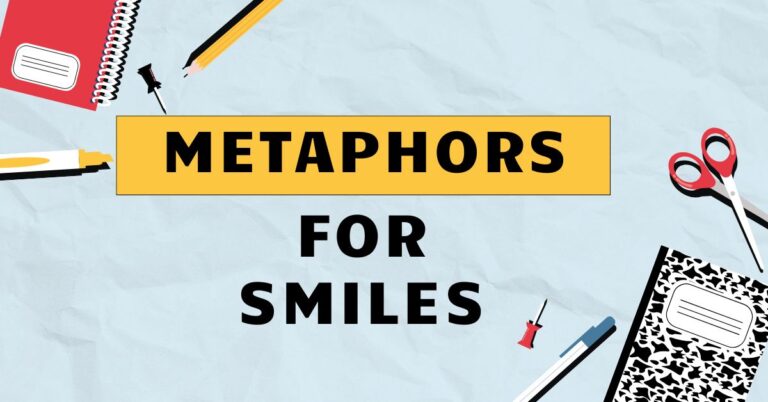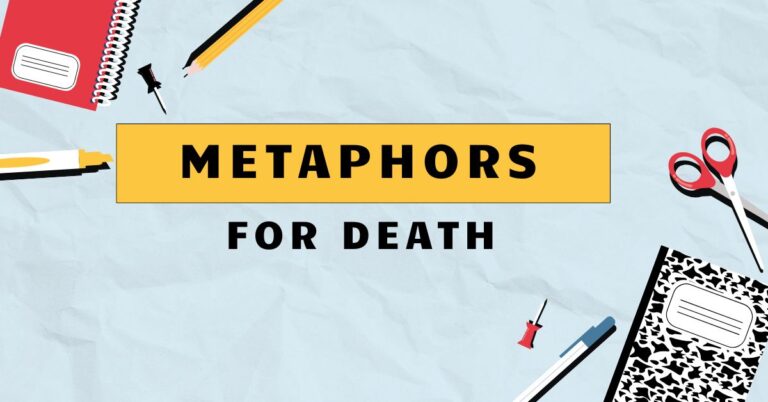47 Metaphors about Change: Understanding Figurative Language
Understanding metaphors of change is crucial for grasping nuanced communication in English. These metaphors are pervasive in everyday language and literature, offering powerful and vivid ways to describe transformations, transitions, and evolving situations.
This article explores the definition, structure, types, usage, and common pitfalls associated with metaphors of change. By mastering this aspect of figurative language, learners can enhance their comprehension and expressiveness in both written and spoken English.
This guide is suitable for English language learners of all levels, from intermediate to advanced, as well as anyone interested in deepening their understanding of figurative language.
Table of Contents
- Definition of Metaphors of Change
- Structural Breakdown
- Types and Categories of Metaphors of Change
- Examples of Metaphors of Change
- Usage Rules
- Common Mistakes
- Practice Exercises
- Advanced Topics
- FAQ
- Conclusion
Definition of Metaphors of Change
A metaphor of change is a figure of speech that describes a transformation or transition from one state to another by comparing it to something else that is not literally applicable. Unlike similes, which use “like” or “as” to make a comparison, metaphors directly equate the subject of change with something else, implying a similarity or shared quality.
Metaphors of change are central to how we understand and communicate about evolving situations, personal growth, and societal shifts. They allow us to express complex and abstract concepts in a more relatable and vivid way.
The function of metaphors of change is to provide a new perspective on a situation, making it more understandable or emotionally resonant. They are frequently used in literature, poetry, speeches, and everyday conversation to add depth and color to language.
By using a metaphor, a speaker or writer can evoke a strong image or feeling in the audience, making the message more memorable and impactful. These metaphors often tap into shared cultural understandings and experiences, making them highly effective communication tools.
Metaphors of change can be found in a variety of contexts, ranging from personal development and career transitions to political discourse and environmental discussions. For example, describing a person’s recovery from illness as a “rebirth” is a metaphor of change.
Similarly, referring to a company’s restructuring as “pruning dead branches” utilizes a metaphor to convey the idea of necessary but potentially painful changes. Understanding the nuances of these metaphors is essential for effective communication and critical thinking.
Structural Breakdown
Metaphors of change, like all metaphors, consist of two main elements: thetenorand thevehicle. The tenor is the subject being described – the thing that is changing.
The vehicle is the thing to which the tenor is being compared – the source of the metaphorical meaning. Understanding the relationship between the tenor and the vehicle is key to interpreting the metaphor correctly.
The structure of a metaphor of change often implies a process or transformation. The vehicle typically represents a dynamic process that mirrors the change occurring in the tenor.
For example, if we say “He blossomed into a confident speaker,” the tenor is “he” (the person who is changing), and the vehicle is “blossomed” (the act of a flower blooming, representing growth and development). The metaphor suggests a gradual and positive transformation.
The effectiveness of a metaphor of change depends on the clarity and relevance of the vehicle. A well-chosen vehicle will resonate with the audience and provide a deeper understanding of the change being described.
Conversely, a poorly chosen vehicle can be confusing or misleading. The context in which the metaphor is used also plays a crucial role in its interpretation.
The surrounding words and sentences can provide clues to the intended meaning and help the audience grasp the connection between the tenor and the vehicle.
Types and Categories of Metaphors of Change
Metaphors of change can be categorized based on the type of transformation they describe. Here are some common categories:
1. Growth and Development Metaphors
These metaphors describe positive changes, often related to personal growth, learning, or improvement. They frequently use imagery of plants, seeds, and natural processes.
2. Decay and Decline Metaphors
These metaphors illustrate negative changes, such as deterioration, loss, or failure. They often involve images of rust, rot, and destruction.
3. Transformation Metaphors
These metaphors depict radical or fundamental changes, often involving a complete alteration of form or character. They may use imagery of metamorphosis, alchemy, or rebirth.
4. Movement and Transition Metaphors
These metaphors describe changes in location, state, or condition, often involving imagery of journeys, paths, and shifting landscapes. They highlight the process of moving from one point to another.
5. Cyclical Metaphors
These metaphors represent changes that occur in a repeating pattern, such as seasons, tides, or life cycles. They emphasize the recurring nature of change and the inevitability of certain processes.
Examples of Metaphors of Change
Here are some examples of metaphors of change, categorized by type:
Table 1: Growth and Development Metaphors
This table provides examples of metaphors that describe growth and positive development. Each example includes the metaphor, its analysis, and its intended meaning.
| Metaphor | Analysis | Meaning |
|---|---|---|
| He sprouted into a confident leader. | “Sprouted” compares his growth to a plant emerging from the ground. | He developed leadership skills quickly and visibly. |
| Her ideas blossomed into a successful business. | “Blossomed” likens the development of her ideas to a flower blooming. | Her ideas grew and flourished, leading to a thriving business. |
| The project germinated slowly but surely. | “Germinated” compares the project’s initial development to a seed sprouting. | The project started slowly but gradually progressed towards success. |
| He cultivated strong relationships with his colleagues. | “Cultivated” compares building relationships to tending a garden. | He carefully nurtured and developed positive relationships at work. |
| She nurtured her talent until it bore fruit. | “Nurtured” and “bore fruit” compare talent development to growing a plant. | She developed her talent until it produced successful results. |
| The company’s profits have been growing like weeds. | “Growing like weeds” compares rapid growth to the uncontrolled spread of weeds. | The company’s profits have increased very quickly and significantly. |
| He was a diamond in the rough, waiting to be polished. | “Diamond in the rough” compares potential to an unrefined gem. | He had hidden talent that needed to be developed. |
| Her skills matured over time. | “Matured” compares skill development to the ripening of fruit. | Her skills improved and developed with experience. |
| The team’s synergy blossomed after the workshop. | “Blossomed” compares the improvement in team synergy to a flower blooming. | The team’s ability to work together improved significantly after the workshop. |
| He grew into his role as CEO. | “Grew into” compares his adaptation to a plant growing to fit its environment. | He gradually adapted to and excelled in his position as CEO. |
| The small business expanded its roots into new markets. | “Expanded its roots” compares business growth to a tree extending its roots. | The business grew and established itself in new markets. |
| The relationship between the two countries blossomed into a strong alliance. | “Blossomed” compares the development of the relationship to a flower blooming. | The relationship between the two countries grew stronger and more positive. |
| She blossomed into a talented artist. | “Blossomed” compares her development as an artist to a flower blooming. | She developed her artistic skills and became a talented artist. |
| His confidence grew exponentially after his success. | “Grew exponentially” compares the increase in confidence to rapid mathematical growth. | His confidence increased very quickly and significantly after his success. |
| The community garden flourished under her leadership. | “Flourished” compares the success of the garden to a plant thriving. | The community garden grew and thrived due to her effective leadership. |
| He allowed his creativity to bloom. | “Bloom” compares the expression of creativity to a flower blooming. | He encouraged and expressed his creative abilities. |
| Her career took root in the tech industry. | “Took root” compares the beginning of her career to a plant establishing roots. | She began her career and became established in the tech industry. |
| The project bore fruit after years of hard work. | “Bore fruit” compares the success of the project to a plant producing fruit. | The project finally achieved successful results after a long period of effort. |
| His teaching style evolved over time. | “Evolved” compares the change in his teaching style to a biological evolution. | His teaching style gradually changed and improved over time. |
| The company’s culture matured into one of collaboration and innovation. | “Matured” compares the development of the company’s culture to the ripening of fruit. | The company’s culture gradually developed into one that fostered collaboration and innovation. |
Table 2: Decay and Decline Metaphors
This table contains examples of metaphors that describe decay, decline, and negative changes. It includes the metaphor, its analysis, and its intended meaning.
| Metaphor | Analysis | Meaning |
|---|---|---|
| His health deteriorated rapidly. | “Deteriorated” compares his declining health to something breaking down. | His health declined quickly and significantly. |
| The company’s reputation crumbled after the scandal. | “Crumbled” compares the damage to the reputation to something falling apart. | The company’s reputation was severely damaged by the scandal. |
| Their relationship soured over time. | “Soured” compares the worsening relationship to milk turning sour. | Their relationship became unpleasant and negative. |
| The building decayed slowly over the years. | “Decayed” compares the building’s decline to organic matter rotting. | The building gradually deteriorated due to neglect and age. |
| Her dreams withered after repeated setbacks. | “Withered” compares the fading dreams to a plant drying up. | Her dreams faded and died due to repeated failures. |
| The project stagnated due to lack of funding. | “Stagnated” compares the project’s lack of progress to still, foul water. | The project stopped progressing because of insufficient funding. |
| His career prospects rusted away. | “Rusted away” compares the decline of prospects to metal corroding. | His career opportunities deteriorated and disappeared over time. |
| The city’s infrastructure is crumbling. | “Crumbling” compares the decay of infrastructure to something falling apart. | The city’s roads, bridges, and other infrastructure are deteriorating. |
| Her spirit flagged after the long illness. | “Flagged” compares her weakened spirit to a drooping flag. | Her energy and enthusiasm declined after the prolonged illness. |
| The team’s morale eroded after the layoffs. | “Eroded” compares the decline in morale to soil being washed away. | The team’s morale decreased gradually due to the job losses. |
| The support for the policy evaporated after the controversy. | “Evaporated” compares the loss of support to water turning into vapor. | The support for the policy disappeared quickly after the controversy. |
| His memory faded with age. | “Faded” compares the loss of memory to a color losing its brightness. | His ability to remember things decreased as he got older. |
| The organization’s influence waned over the years. | “Waned” compares the decline in influence to the moon decreasing in size. | The organization’s power and impact decreased over time. |
| The initial excitement fizzled out quickly. | “Fizzled out” compares the fading excitement to a sparkling drink losing its bubbles. | The initial enthusiasm disappeared rapidly. |
| Their friendship dissolved after the argument. | “Dissolved” compares the end of the friendship to a substance breaking down in water. | Their friendship ended completely after the disagreement. |
| The project’s momentum petered out. | “Petered out” compares the slowing of momentum to a fire gradually dying down. | The project gradually lost its energy and progress slowed. |
| His savings dwindled over the years. | “Dwindled” compares the decrease in savings to something gradually shrinking. | His savings gradually decreased over time. |
| The company’s market share slipped after the new competitor emerged. | “Slipped” compares the loss of market share to someone losing their footing. | The company’s portion of the market decreased due to the new competition. |
| Her enthusiasm waned as the task became more difficult. | “Waned” compares the decrease in enthusiasm to the moon decreasing in size. | Her enthusiasm decreased as the task became more challenging. |
| The old traditions are fading away. | “Fading away” compares the disappearance of traditions to a color losing its brightness. | The old customs and practices are gradually disappearing. |
Table 3: Transformation Metaphors
This table provides examples of metaphors that describe radical or fundamental changes. Each example includes the metaphor, its analysis, and its intended meaning.
| Metaphor | Analysis | Meaning |
|---|---|---|
| He was reborn after his near-death experience. | “Reborn” compares his new outlook to being born again. | He experienced a profound change in perspective and values. |
| The caterpillar transformed into a butterfly. | “Transformed” likens the change to the metamorphosis of a caterpillar. | A complete and beautiful change occurred. |
| The company reinvented itself to stay competitive. | “Reinvented” compares the company’s changes to creating something new. | The company completely changed its strategies and image. |
| She metamorphosed into a confident public speaker. | “Metamorphosed” compares her transformation to the change of an insect. | She underwent a significant and complete change in her speaking abilities. |
| The city underwent a radical makeover. | “Makeover” compares the changes to a cosmetic transformation. | The city experienced significant and visible changes. |
| He shed his old skin and embraced a new identity. | “Shed his old skin” compares the change to a snake shedding its skin. | He abandoned his former self and adopted a new persona. |
| The industry was revolutionized by the new technology. | “Revolutionized” compares the change to a major social or political upheaval. | The new technology caused a complete and fundamental change in the industry. |
| The old factory was converted into luxury apartments. | “Converted” compares the change to transforming something from one use to another. | The factory was transformed into a completely different type of building. |
| He emerged from the crisis a changed man. | “Emerged” implies a transformation after a difficult period. | He was fundamentally different after experiencing the crisis. |
| The political landscape shifted dramatically after the election. | “Shifted” compares the change to a change in physical position. | The political situation changed significantly after the election. |
| The software was upgraded to a completely new version. | “Upgraded” compares the change to improving or enhancing something. | The software was transformed to a more advanced and improved version. |
| The outdated laws were reformed to reflect modern values. | “Reformed” compares the change to improving or correcting something. | The laws were changed to better align with current societal values. |
| He traded his corporate suit for a life of adventure. | “Traded” compares the change to exchanging one thing for another. | He completely changed his lifestyle from a corporate job to an adventurous life. |
| The company transitioned to a new business model. | “Transitioned” compares the change to moving from one state to another. | The company adopted a new and different way of doing business. |
| The building was renovated to meet modern standards. | “Renovated” compares the change to restoring or improving something. | The building was updated to comply with current requirements. |
| The curriculum was revamped to include new subjects. | “Revamped” compares the change to overhauling or improving something. | The curriculum was significantly changed to incorporate new topics. |
| He flipped his life around after hitting rock bottom. | “Flipped around” compares the change to reversing or turning something over. | He completely changed his life for the better after a difficult period. |
| The rules were rewritten to ensure fairness. | “Rewritten” compares the change to creating a new version of something. | The rules were changed to promote equality and justice. |
| The company was restructured to improve efficiency. | “Restructured” compares the change to reorganizing something. | The company was reorganized to operate more effectively. |
| The plot twisted unexpectedly in the final act. | “Twisted” compares the change to a sudden turn or shift. | The storyline changed dramatically and surprisingly at the end. |
Usage Rules
When using metaphors of change, it’s important to ensure that the comparison is both clear and relevant. The vehicle should be something that the audience can easily understand and relate to.
Avoid using metaphors that are too obscure or abstract, as this can lead to confusion. Also, consider the connotations of the vehicle.
The chosen image should evoke the desired feeling or association.
Consistency is another crucial aspect of using metaphors effectively. Once you establish a metaphor, avoid mixing it with other unrelated images.
For example, if you’re describing a company’s growth using a gardening metaphor, stick to terms related to plants and cultivation. Mixing in metaphors from other domains can create a jarring and confusing effect.
Be mindful of clichés. Overused metaphors can lose their impact and become meaningless.
Try to find fresh and original ways to express your ideas. Consider the context in which you are using the metaphor.
A metaphor that works well in one situation may be inappropriate in another. Pay attention to the tone and style of your writing or speaking and choose metaphors that fit the overall mood.
Common Mistakes
One common mistake is using mixed metaphors, where two or more inconsistent metaphors are combined in a single statement. Incorrect: “He was skating on thin ice while climbing the ladder of success.” This mixes the image of skating on ice with climbing a ladder, creating a confusing and illogical picture. Correct: “He was skating on thin ice.” or “He was climbing the ladder of success.”
Another error is using metaphors that are too vague or abstract. Incorrect: “The situation is a cloud.” This metaphor lacks specificity and doesn’t provide a clear understanding of the situation. Correct: “The situation is a gathering storm, threatening to disrupt our plans.” This provides a more vivid and informative comparison.
Overusing metaphors can also weaken their impact. Incorrect: “His words were a river, flowing with ideas that were seeds of change, sprouting in the minds of the audience like a garden.” This contains too many metaphors in one sentence, making it overwhelming and difficult to follow. Correct: “His words sparked new ideas in the audience’s minds.”
Practice Exercises
Exercise 1: Identifying Metaphors of Change
Identify the metaphors of change in the following sentences and explain what type of change they represent (growth, decay, transformation, etc.).
| Question | Answer |
|---|---|
| 1. The old regime crumbled under the weight of public discontent. | Metaphor: “crumbled”; Type: Decay and Decline |
| 2. She blossomed into a confident and successful entrepreneur. | Metaphor: “blossomed”; Type: Growth and Development |
| 3. The company reinvented itself to adapt to the changing market. | Metaphor: “reinvented”; Type: Transformation |
| 4. His dreams withered after years of rejection. | Metaphor: “withered”; Type: Decay and Decline |
| 5. The project germinated slowly but eventually flourished. | Metaphor: “germinated,” “flourished”; Type: Growth and Development |
| 6. The city underwent a massive transformation with the new development projects. | Metaphor: “transformation”; Type: Transformation |
| 7. Their relationship soured over time due to constant disagreements. | Metaphor: “soured”; Type: Decay and Decline |
| 8. He emerged from the crisis a stronger and more resilient leader. | Metaphor: “emerged”; Type: Transformation |
| 9. The support for the policy evaporated after the scandal broke. | Metaphor: “evaporated”; Type: Decay and Decline |
| 10. The small seed of an idea grew into a successful business venture. | Metaphor: “grew”; Type: Growth and Development |
Exercise 2: Completing Metaphors of Change
Complete the following sentences by adding an appropriate metaphor of change.
| Question | Answer |
|---|---|
| 1. After years of hard work, her efforts finally _____. | bore fruit |
| 2. The old traditions are slowly _____. | fading away |
| 3. The company’s profits _____ after the new product launch. | skyrocketed |
| 4. His initial enthusiasm _____ as the project dragged on. | waned |
| 5. The caterpillar _____ into a beautiful butterfly. | transformed |
| 6. The political landscape _____ after the election results. | shifted |
| 7. The support for the initiative _____ after the controversy. | evaporated |
| 8. The team’s morale _____ after the repeated failures. | plummeted |
| 9. The company _____ to adapt to the new market conditions. | evolved |
| 10. His writing style _____ over time with practice. | matured |
Advanced Topics
At an advanced level, learners can explore the use of extended metaphors of change, where a single metaphor is developed over several sentences or paragraphs. This technique can create a powerful and sustained image, adding depth and complexity to the writing.
Analyzing the cultural and historical context of metaphors can also provide a deeper understanding of their meaning and impact. Certain metaphors may carry specific connotations or associations within a particular culture or historical period.
Another advanced topic is the use of mixed metaphors for stylistic effect. While mixed metaphors are generally considered an error, they can be used deliberately to create a humorous or surreal effect.
However, this should be done with caution and only when the intended meaning is clear. Exploring the relationship between metaphors of change and other figures of speech, such as metonymy and synecdoche, can also enhance understanding of figurative language.
FAQ
- What is the difference between a metaphor and a simile?
A metaphor directly equates two things, while a simile uses “like” or “as” to make a comparison. For example, “He is a lion” (metaphor) vs. “He is brave like a lion” (simile).
- How can I avoid using clichés in my metaphors?
Try to think of fresh and original ways to express your ideas. Look for unexpected connections between the tenor and the vehicle. Read widely and pay attention to how other writers use metaphors effectively.
- What is a mixed metaphor, and why should I avoid it?
A mixed metaphor combines two or more inconsistent metaphors in a single statement, creating a confusing and illogical image. It should generally be avoided because it weakens the clarity and impact of the writing.
- How can I improve my understanding of metaphors of change?
Read widely and pay attention to how metaphors are used in different contexts. Practice identifying metaphors in texts and analyzing their meaning. Experiment with creating your own metaphors.
- What are the key elements of a metaphor of change?
The key elements are the tenor (the subject being described) and the vehicle (the thing to which the tenor is being compared). The vehicle should be relevant and evoke the desired feeling or association.
- How do metaphors of change differ from other types of metaphors?
Metaphors of change specifically describe transformations or transitions. They focus on the process of moving from one state to another, while other metaphors may describe static qualities or relationships.
- Can metaphors of change be used in formal writing?
Yes, but they should be used judiciously. Choose metaphors that are appropriate for the tone and style of the writing, and avoid using clichés or mixed metaphors.
- What is the role of context in interpreting metaphors of change?
Context is crucial for understanding the intended meaning of a metaphor. The surrounding words and sentences can provide clues to the relationship between the tenor and the vehicle. Cultural and historical context can also be important.
- Why are metaphors of change important in communication?
Metaphors of change help us understand complex and abstract ideas by relating them to familiar concepts. They add depth and color to our language, making it more engaging and memorable.
- How can I use metaphors of change to make my writing more persuasive?
By using vivid and relatable metaphors, you can evoke strong emotions and create a lasting impression on your audience. This can make your writing more persuasive and impactful.
Conclusion
Metaphors of change are powerful tools for expressing complex ideas and evoking strong emotions. By understanding their structure, types, and usage, learners can enhance their comprehension and expressiveness in English.
Avoiding common mistakes, such as mixed metaphors and clichés, is essential for effective communication. Practice identifying and creating metaphors in various contexts to master this aspect of figurative language.
Remember to consider the cultural and historical context of metaphors to fully appreciate their meaning and impact.
The ability to effectively use metaphors of change is a valuable skill for anyone seeking to improve their communication abilities. Whether you are writing a poem, delivering a speech, or simply engaging in everyday conversation, metaphors can add depth, color, and impact to your words.
Continue to explore and experiment with metaphors to unlock their full potential and become a more skilled and effective communicator.

